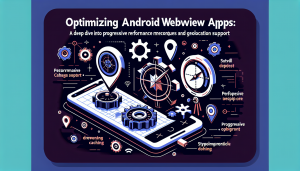
In the realm of mobile app development, creating a seamless user experience is paramount. Amongst the various strategies employed, turning web applications into native Android apps using WebView has become increasingly popular. However, one of the challenges developers face is ensuring that this hybrid approach does not compromise on performance. In this deep dive, we will explore how developers can leverage progressive performance cache mechanisms and integrate robust geolocation support into their Android WebView apps.
Understanding Progressive Performance Cache Mechanisms
Caching is a critical component for enhancing the performance of WebView apps. By storing web resources locally on the device, apps can load faster, reduce data usage, and provide content to users without an internet connection. Progressive caching takes this a step further by not only caching content but also updating it intelligently in the background to ensure users always have the most up-to-date information without sacrificing speed.
Implementing a Smart Caching Strategy
To implement a progressive caching strategy, developers can use service workers. These are essentially scripts that run in the background and manage the caching of resources. Service workers can intercept network requests, cache or retrieve resources from the cache, and deliver them to the WebView. This process is instrumental in creating a smooth and efficient user experience.
The Role of Geolocation in Enhancing User Experience
Geolocation services are an integral part of many modern mobile apps, providing contextual and personalized experiences based on a user’s location. Integrating geolocation into WebView apps can be a bit more complex due to the security and privacy implications, but when done right, it allows for features like location-based notifications, mapping, and more engaging user interactions.
Geolocation Support in WebView: Best Practices
When incorporating geolocation into WebView apps, developers should prioritize user consent and privacy. This means ensuring that the app only accesses location data when necessary and with the user’s explicit permission. Additionally, accuracy and efficiency should be balanced to avoid excessive battery drain. Utilizing APIs like the Geolocation API can simplify this process, providing a straightforward way for WebView apps to access location data.
WebViewGold: Your Shortcut to Optimized WebView Apps
While implementing these optimizations can seem daunting, there are solutions like WebViewGold.com/>WebViewGold that streamline the process. This platform offers a quick and simple way to convert websites into high-performance Android apps. It comes with built-in progressive caching features and geolocation support, saving developers time while ensuring that their apps deliver the best possible user experience.
Conclusion: Striking the Right Balance
Achieving optimal performance in Android WebView apps does require attention to detail and a willingness to adopt advanced techniques like progressive performance caching and geolocation support. However, by understanding the underlying principles and making use of tools like WebViewGold, developers can create apps that not only perform well but also offer users the features and capabilities they expect from top-tier mobile experiences.




